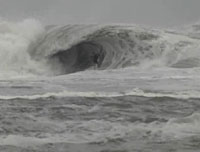
Sunday,
March 25, 2007
Vol.
41 - No 43
Plan for 'big one' in quake-prone areas, says US geophysicist
CHICAGO, (AFP) - The world's most high-risk earthquake zones should be considered lethal and policy makers need warning systems in place in case of a disaster like the 2004 Asian tsunami, a top geophysicist says."These systems need to be strong and they need to be maintained over the long term because we have no way of knowing when the next great earthquake will hit," wrote Robert McCaffrey, professor of geophysics at Rensselaer Polytechnic Institute in Troy, New York, in an editorial in the journal Science.He warned that seismologists simply do not have enough data to predict with accuracy which of many faults in the Earth's crust could yield the next magnitude 9.0 quake. The December 2004 quake off Sumatra, Indonesia, unleashed a tsunami that devastated nations around the Indian Ocean. It occurred in a known hotspot, a subduction zone where one tectonic plate slips beneath another. Some 168,000 people died in Aceh province.Even so, seismologists thought the fault was an unlikely spot for a quake. A hundred years of records indicated the age and speed of the subducting plate were the most important factors in determining the occurrence of a magnitude 9.0 quake.Given the extent of the damage, McCaffrey wrote, the facts suggest that the limited historical record is insufficient for mapping a trend in geographical events that could span centuries or millennia. A magnitude 9.0 quake can be created by 20 metres of slip between two converging plates. However, slips of this length only occur every 200 to 1,000 years or more at a particular boundary, leaving no historic records to track their frequency. Magnitude 9.0 quakes typically occur in subduction zones."It's not that the science is bad, but we don't have enough data. We've only been watching these processes for 100 years," McCaffrey said. In the absence of reliable forecasting data, policy makers should consider all subduction zones, from Chile to Java, as lethal, McCaffrey said. The highest magnitude earthquake ever recorded was 9.5 in Chile in 1960.Geologists now use moment magnitude scale, which measures the maximum magnitude, the size of the quake's rupture, amount of slip and the force released. "Several are near densely populated land areas, and the potential impacts of shaking and tsunamis cannot be overstated," he wrote.Given the experience of 2004 and the fact that so much damage was done so far from the quake zone, authorities should create warning systems with input and support from many countries, he said. "We can never forget what happened," he wrote. "Now is the time to use the knowledge that we have gained and work to save lives should another magnitude 9.0 hit tomorrow or hundreds of years from now. "Many didn't know about tsunamis before the quake; we must make sure that now they never fail to remember their destructive force." |
| || Front
Page | News
| Editorial
| Columns
| Sports
| Plus
| Financial
Times | International
| Mirror
| TV
Times | Funday
Times || |
| |
Copyright
2007 Wijeya
Newspapers Ltd.Colombo. Sri Lanka. |
